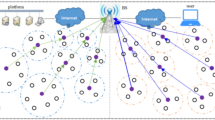Abstract
In this paper, a low-energy adaptive clustering hierarchy (LEACH)-based routing protocol for wireless sensor networks (WSNs) is presented. The proposed protocol is labeled (ASTEEN) referring to an adaptive soft-thresholding-based energy-efficient sensor network. Its objective is to allow less energy consumption for data transition that affects the lifetime of the network. So, the node lifetime increases, and also the network lifetime increases. In contrary to other fixed soft-thresholding-based protocols, the adaptive soft threshold dynamically gets lower as the significance of the value of the sensed physical parameter increases. This leads to less-frequent transmission of less-critical sensed values, and more frequent transmission of more critical sensed values. This paper examines the correlated and uncorrelated sensed data values with the proposed protocol, and the performance is compared with those of other protocols. The proposed protocol succeeds in the sensing of samples with high correlation.























Similar content being viewed by others
Data availability
The datasets generated during the current study are available from the corresponding author on reasonable request.
Code availability
The custom code is available.
References
Javaid, N., Mohammad, S. N., Latif, K., Qasim, U., & Khan, M. A. (2013). HEER: Hybrid energy efficient reactive protocol for wireless sensor networks. In: 2013 Saudi international electronics communications and photonics conference (SIECPC).
Kaur, E. S., & Gupta, E. R. (2015). Deploying an optimized LEACH-C protocol for wireless sensor network. International Journal of Advanced Research in Computer Science and Software Engineering (IJARCSSE), 5(7), 25–30.
Singh, S. P., & Sharma, S. C. (2015). A survey on cluster based routing protocols in wireless sensor networks. Procedia Computer Science, 45, 687–695.
Heinzelman, W., Chandrakasan, A., & Balakrishnan, H. (2000). Energy efficient communication protocol for wireless sensor networks. In: Proceedings of the 33rd Hawaii international conference on system science 2.
Heinzelman, W., Chandrakasan, A., & Balakrishnan, H. (2002). An application-specific protocol architecture for wireless microsensor networks. IEEE Transactions on Wireless Communications, 1(4), 660–670.
Arora, V., Sharma, V., & Sachdeva, M. (2016). A survey on LEACH and other’s routing protocols in wireless sensor network. Optik, 127(16), 6590–6600.
Lindsey, S., & Raghavendra, C. (2002). PEGASIS: Power-efficient gathering in sensor information systems. In: IEEE aerospace conference proceedings Vol. 3 (pp. 1125–1130).
Manjeshwar, A., & Agarwal, D. (2001). TEEN: A routing protocol for enhanced efficiency in wireless sensor networks. In: 15th International parallel and distributed processing symposium (IPDPS’01) 3.
Tamanna, S. A. (2016) Analyze and implementation of TEEN protocol in wireless sensor network. International Journal of Innovative Research in Science Engineering and Technology (IJIRSET), 5(3).
Dehghania, S., Pourzaferani, M., & Barekatain, B. (2015). Comparison on energy-efficient cluster based routing algorithms in wireless sensor network. Procedia Computer Science, 72, 535–542.
Manjeshwar, A., & Agarwal, D. (2002). APTEEN: A hybrid protocol for efficient routing and comprehensive information retrieval in wireless sensor networks. In: Proceedings of the 16th international parallel and distributed processing symposium (pp. 195–202).
Yi, D., & Yang, H. (2016). HEER: A delay-aware and energy-efficient routing protocol for wireless sensor networks. Computer Networks, 104, 155–173.
Akkaria, W., Bouhdida, B., & Belghith, A. (2015). LEATCH: Low energy adaptive tier clustering hierarchy. Procedia Computer Science, 52, 365–372.
Acknowledgements
The authors would like to acknowledge the support received from Taif University Researchers Supporting Project Number (TURSP-2020/147), Taif University, Taif, Saudi Arabia.
Author information
Authors and Affiliations
Corresponding author
Ethics declarations
Conflict of interest
All authors declared that they have no conflict of interest.
Additional information
Publisher's Note
Springer Nature remains neutral with regard to jurisdictional claims in published maps and institutional affiliations.
Rights and permissions
About this article
Cite this article
Ahmed, R.A., Ahmed, Z.A., Abd-Elnaby, M. et al. Energy-Efficient Routing Protocol Based on Adaptive Soft Thresholding for Wireless Sensor Networks. Wireless Pers Commun 124, 2661–2676 (2022). https://doi.org/10.1007/s11277-022-09483-7
Accepted:
Published:
Issue Date:
DOI: https://doi.org/10.1007/s11277-022-09483-7




